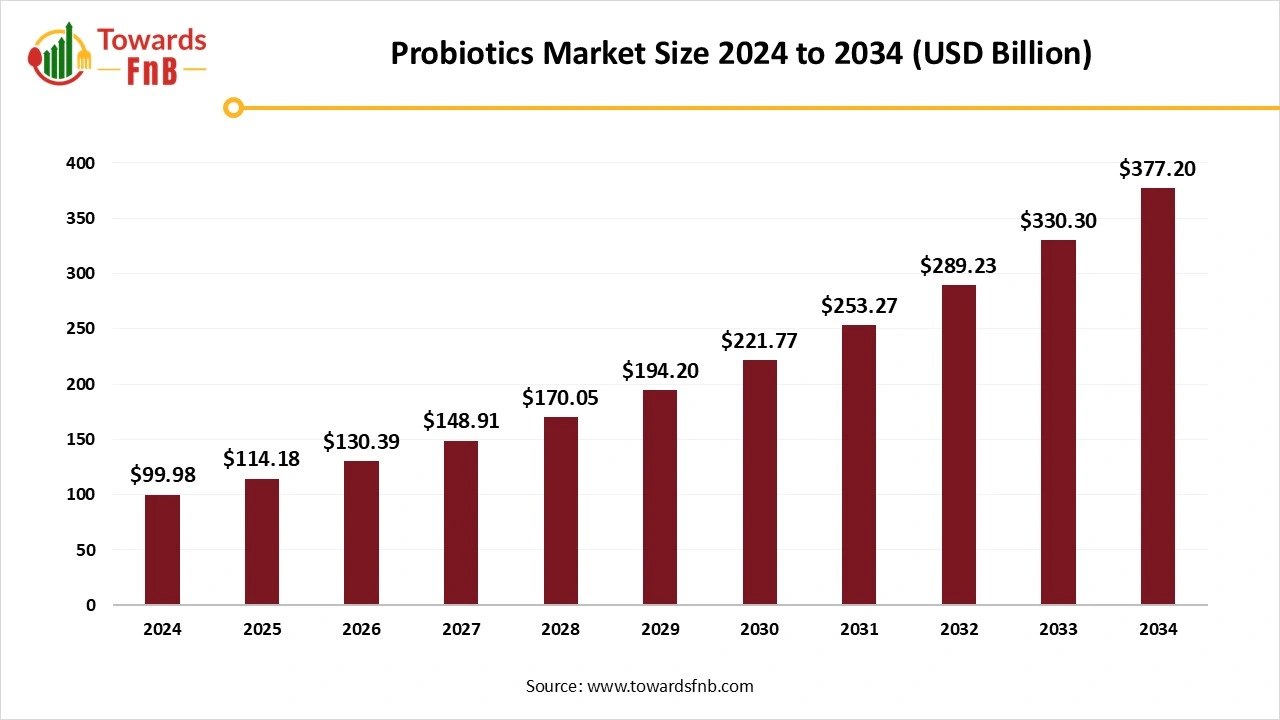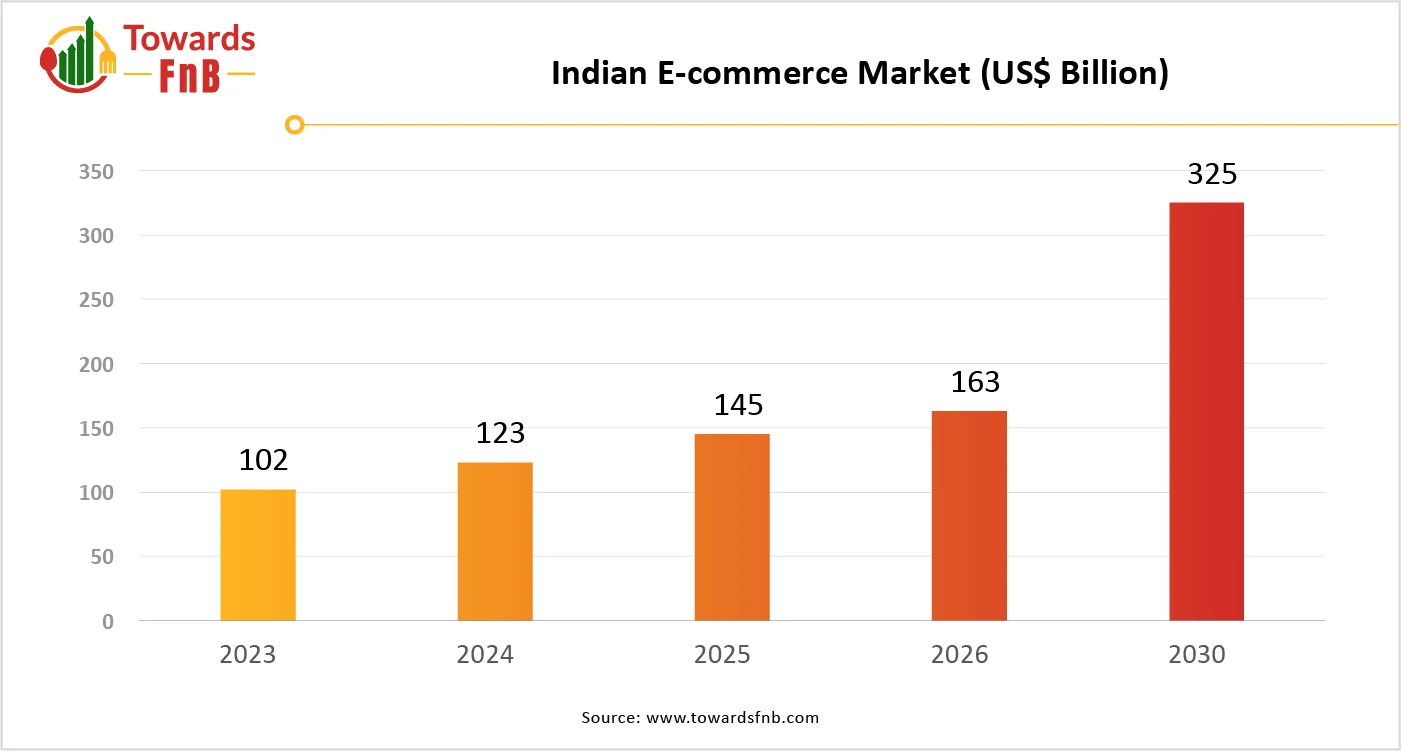April 2025
The global probiotic food market size grew from USD 99.98 billion in 2024 to USD 377.2 billion by 2034, with an expected CAGR of 14.20% during the forecast period from 2025 to 2034. The rising consumer awareness regarding gut health, convenience purchase, rising applications in various sectors, and growing digestive issues in consumers drive the growth of the market.

Probiotics are foods that consist of yeast or live organisms that provide benefits to gut health. They promote the growth of good bacteria in the body. They are available in fermented foods such as tempeh, miso, kombucha, aged cheese, yogurt, kefir, sauerkraut and many more. Probiotics are available in dietary supplements such as powders, capsules, tablets, chews, and liquids. There are various types of probiotics available, such as lactobacillus, Bifidobacterium, and saccharomyces boulardii. Probiotics help to improve digestion, boost immunity, reduce gut problems, reduce cholesterol, and manage weight.
Factors such as growing natural remedies, rising demand for probiotics in sports, and growing consumer awareness about gut health are responsible for the growth of the market. The growing demand for animal probiotics and the expansion of distribution channels are fueling the growth of the market.
E-commerce’s Expansion to Offer Market a Potential
The trending e-commerce market boosts the growth of the probiotic market. E-commerce provides convenience to consumers; due to this, they can purchase probiotics from anywhere and anytime. On online platforms, various brands can promote their product through different channels. The availability of 24/7 shopping and the convenience of comparing various probiotics products help in market growth.
Consumers' busy lifestyles increase the demand for online shopping, which saves time and effort. Consumers can easily read reviews, compare prices, and understand product features on online platforms. Rise in subscription-based services, personalised products, and improved consumer experience due to e-commerce fuels market growth. Rising availability, convenience, and brand engagement to wider audiences make e-commerce a key driver for the growth of probiotics foods.

Innovations in probiotic foods create an opportunity to market. Technological advancement includes improving stability, viability, and delivery of probiotic products. Researchers are working on innovating new probiotic strains that improve health benefits. The development of a new variety of flavors and formulations helps to attract consumers. The growing companies' investment in researching new strains of probiotics creates a strong opportunity for market growth.
Advanced techniques like microencapsulation, nanotechnology, and gene editing enhance the effectiveness and safety of probiotic foods. Manufacturing probiotics to personal needs potentially going to help in market growth. In the future, techniques like advancement in biotechnology and 3D printing of probiotics will create strong opportunities in the growth of the market.
Despite several advantages related to probiotic foods, there are some disadvantages like side effects that develop in some cases by consuming probiotic foods, such as gas, bloating, diarrhea, abdominal discomfort, and nausea. Amines present in probiotics foods trigger headaches in some people. In some cases, it causes allergic reactions such as rash, itching, swelling, and dizziness. In rare cases, infections such as sepsis may occur in ill patients. The several side effects of probiotics may hamper the growth of the market.
Asia Pacific: Powerhouse of Probiotic Food
Asia Pacific dominated the probiotic food market in 2024. The rising awareness about gut health and a healthy gut microbiome drives the growth of the market in the region. The strong tradition of consuming fermented foods and growing digestive issues in consumers helps in market growth. The growing health-conscious people demand probiotic foods in their diet. Rising disposable income and government initiatives in promoting probiotics in the region drive the growth of the market. Furthermore, growing innovations in product development in the region fuel market growth.
India dominated the probiotic food market in the Asia Pacific region. The rising gastrointestinal problems and consumer awareness regarding overall health drive the growth of the market in the region. The rising population, lifestyle changes, and growing middle class in the country drive the growth of the market in the country. For instance, in India, the government initiatives like National Nutrition Mission helps in the growth of the market.
North America’s Unstoppable growth in probiotic food
North America is the fastest-growing market during the forecast period. The growing consumer awareness of digestive health and rising adoption of natural healthcare remedies drive the growth of the market in the region. The growing various health issues in consumers increases the demand for probiotic foods to boost immunity. Innovations in probiotic foods in the food and beverage sector help in market growth. Strong economies in countries like the U.S. and Canada and expanded distribution networks support the market growth in the region.
United States dominates the probiotic food market in North America. The rising disposable income and growing health consciousness among American consumers drive the growth of the market in the country. United States consists of strong distribution channels such as online and hypermarkets/supermarkets. The rising product innovation in the United States and the presence of key players drive the growth of the market.
The probiotic food & beverage segment dominated the probiotic food market in 2024.
Rising consumer awareness regarding gut health and increased preference for functional foods drive the growth of the market. Beverages that include probiotics contain live microorganism that improves immunity power and gut health. Probiotic foods are infused in various food products like nutrition bars, granola bars, vegetables, soy, and many more, fueling the market growth. Beverages like juices, smoothies, and yogurt drinks contain probiotics to heal the gut. The growing awareness about eating probiotic and innovations of dishes and beverages further drive the growth of the market.
The probiotic dietary supplement segment is the fastest-growing segment during the forecast period. Rising immunity benefits and ease of supplement consumption drive the growth of the market. Consumers are more aware of gut health, and its overall impact on the body increases the demand for probiotic dietary supplements. These supplements are available in various formats, such as powders, capsules, and gummies. Innovations in products according to various concerns like women’s health, sports nutrition, and many more drive the growth of the market. Furthermore, the development of shelf-stable probiotic supplements and their convenience propel the market growth.
The bacteria-based segment dominated the probiotic food market in 2024.
The cost-effective manufacturing process, affordability, and easy accessibility drive the growth of the market. The established benefits and ease of incorporating them in foods fuels the market growth. The bacteria-based probiotics help to improve digestion, boost immunity, and manage irritable bowel syndrome and diarrhea.
The yeast-based segment is the fastest-growing segment during the forecast period. The growing advancement in yeast-based product development and therapeutic benefits drives the growth of the market. Yeast-based probiotics provide benefits such as stimulating the growth of other good bacteria in gut health, anti-inflammatory effects, enhancing absorption of nutrients, and restoring gut microbiome, which fuels the market growth. Furthermore, Yeast-based probiotics supplements contain nutritional value such as proteins, amino acids, and vitamin B and prevent the growth of harmful bacteria & fungi, driving the market growth.
The human segment dominated the probiotic food market in 2024.
The growing awareness about gut health and its effect on overall health drives the growth of the market. The rising availability of probiotics in different varieties, such as fortified foods, beverages, and topical products, fuels the growth of the market. Growing innovations in product development and availability on different distribution channels help in market growth.
The animal segment is the fastest-growing market during the forecast period.
The rising demand for sustainable options in the livestock industry and the lowering of the usage of antibiotics in animal health drive the growth of the market. The high disposable income increases the demand for animal protein sources and helps in market growth. Probiotics offer various benefits to animal health, such as improving gut microbiome, enhancing digestion, and improving feed efficiency. Furthermore, rising focus on animal welfare and protecting animals from diseases drives the growth of the market.
The hypermarkets/ Supermarkets segment dominated the probiotic food market in 2024.
The availability of a wide variety of products, such as yogurt, kefir, fruit beverages, and many more at a single stop, drives the market's growth. Consumers can easily purchase probiotic foods along with other groceries in one location. The growing private-label probiotic food brands in retail stores fuel the growth of the market.
The online store segment is the fastest-growing market during the forecast period. The rising consumer preference for online shopping due to its convenience drives the growth of the market. On online platforms, there are a variety of products available, and consumers can easily read reviews about products. Online platforms offer discounts, promo codes, and sales to consumers, which drives the growth of the market. Furthermore, online stores are available 24/7, and it is easy to shop from anywhere, which fuels the market growth. In the busy lifestyles of consumers, online shopping helps to save time and propels market growth.
By Product
By Ingredient
By End-Use
By Distribution
By Region
April 2025
April 2025
April 2025
April 2025